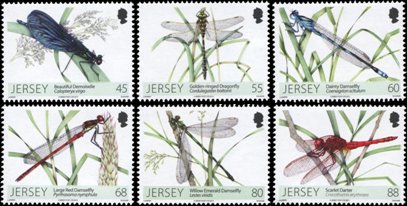The
Stamp

Six stamps featuring dragonflies
and damselflies native to Jersey were issued by Jersey Post on 4 July 2013.
The stamps have been produced to commemorate the 30th anniversary of the
British Dragonfly Society (BDS) and have been painted by natural history
illustrator, Lizzie Harper.
The aim of the society is to promote
and encourage the study and conservation of Odonata and their natural habitats
and Jersey is home to several striking species that can be seen from early
spring until late summer around woodland streams, ponds and reservoirs.
Members of the BDS were already aware
of Lizzie Harper's work as she is a prolific artist who has been commissioned
by many high-profile clients including National Geographic Magazine, London
Zoo, Cambridge University Press and BBC Books. This is her third commission
for Jersey Post following Roses in 2010 and Europa - Forests in 2011.
The six stamps feature the following
dragonflies and damselflies:
Beautiful Demoiselle (Calopteryx
virgo)
This large damselfly favours stony-bottomed
streams and is on the wing from spring until late summer. Males are unmistakable
with a dark, iridescent blue abdomen and brownish-blue wings. The brown-and-green-coloured
females often perch away from water, blending in with vegetation.
Golden-ringed Dragonfly (Cordulegaster
boltonii)
One of Jersey's largest species,
this dragonfly flies from late spring to late summer, usually hawking over
streams. It often allows a close approach while perched on bushes and other
vegetation. Both male and female are distinctively coloured with a black
abdomen horizontally banded with yellow.
Dainty Damselfly (Coenagrion scitulum)
This small damselfly was recorded
in Jersey in 1940 and 1941 and was not seen again until 2009. Rare in Britain,
it had been extinct there since 1953 until its reappearance in 2010. Its
abdomen is blue with variable black markings and it flies from late spring
to midsummer, frequenting streams and damp meadows.
Large Red Damselfly (Pyrrhosoma nymphula)
This is one of the earliest damselflies
to emerge and it flies from early spring to late summer. The male's slim
abdomen is scarlet with black markings, brighter than the female’s. Widespread
across Jersey, it can usually be seen amongst waterside vegetation at the
edge of ponds and other still water.
Willow Emerald Damselfly (Lestes
viridis)
This damselfly, only recently recorded
in Britain, was first seen in Jersey 60 or 70 years ago and is now widespread.
It can be seen on waterside bushes and trees from June to October. Unlike
other British damselflies, it lays its eggs under thin bark on fresh twigs
overhanging water.
Scarlet Darter (Crocothemis erythraea)
Rare in Jersey and Britain, this
migrant dragonfly was only recorded in Jersey in 1944 and 1945 until recent
years. It usually perches on tall waterside vegetation or on open ground,
sometimes away from water. The male's broad, bright scarlet abdomen is
unmistakable; the female's is slighter and yellowish-brown.
|